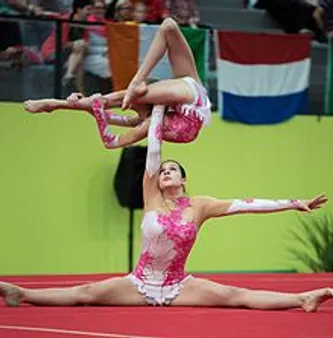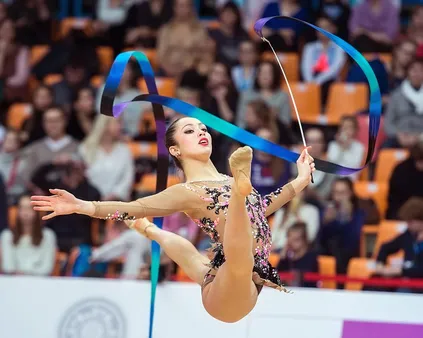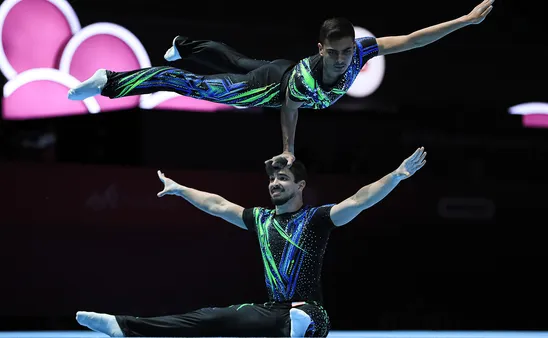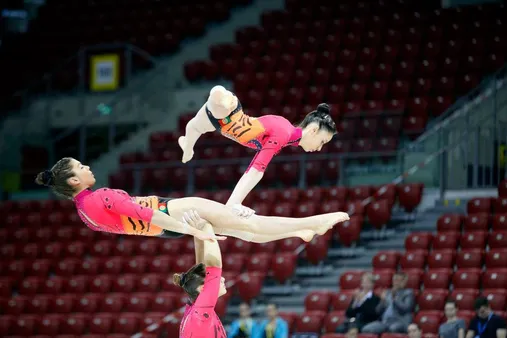Table of Contents
Welcome to Kizworld, your ultimate destination for delving into the captivating world of rhythmic** and acrobatic gymnastics**. Prepare to be mesmerized by the grace, agility, and athleticism of these awe-inspiring sports. Discover the intricate techniques, captivating routines, and captivating performances that define this dynamic discipline. Whether you're an aspiring gymnast, a passionate enthusiast, or simply seeking an adrenaline rush, kizworld is your gateway to the enthralling realm of rhythmic** and acrobatic gymnastics**.
Unveiling the Allure of Rhythmic and Acrobatic Gymnastics: A Journey of Grace and Athleticism
I. History of Acrobatic Gymnastics
History of Acrobatic Gymnastics
The Early Days
The origins of acrobatic gymnastics can be traced back to ancient Greece, where tumblers and acrobats performed at festivals and other public events. These early performers used simple techniques such as handstands, cartwheels, and somersaults to entertain their audiences. Over time, these basic skills were refined and developed into more complex routines, and acrobatic gymnastics began to emerge as a distinct discipline.
In the 19th century, acrobatic gymnastics began to gain popularity in Europe, particularly in Germany and Russia. Gymnasts began to compete against each other in organized competitions, and the sport began to take on a more competitive edge. By the early 20th century, acrobatic gymnastics had become a well-established sport, with its own set of rules and regulations.
The Modern Era
In the 1950s, acrobatic gymnastics was officially recognized by the International Gymnastics Federation (FIG), and the first World Championships were held in 1974. Since then, the sport has continued to grow in popularity, and it is now practiced in over 100 countries around the world. Acrobatic gymnastics is now a regular feature at the Olympic Games, and it is also included in the World Games and the European Championships.
Today, acrobatic gymnastics is a highly competitive sport that requires a great deal of skill, strength, and coordination. Gymnasts perform a variety of acrobatic maneuvers, including flips, twists, and somersaults, while working together in pairs or groups. Acrobatic gymnastics is a visually stunning sport that is enjoyed by audiences of all ages.
The Benefits of Acrobatic Gymnastics
Acrobatic gymnastics offers a number of benefits for participants, including:
- Improved physical fitness
- Increased strength and flexibility
- Enhanced coordination and balance
- Improved self-confidence and self-esteem
- Greater social skills
- A sense of accomplishment
Acrobatic gymnastics is a challenging but rewarding sport that can provide a lifetime of enjoyment. If you are looking for a sport that will help you improve your physical fitness, learn new skills, and make new friends, then acrobatic gymnastics may be the perfect sport for you.
How to Get Started in Acrobatic Gymnastics
If you are interested in trying acrobatic gymnastics, there are a few things you need to do to get started:
- Find a qualified coach.
- Join a gymnastics club.
- Start training regularly.
- Set realistic goals for yourself.
- Have fun!
With hard work and dedication, you can achieve your goals in acrobatic gymnastics. So what are you waiting for? Get started today!
Related Posts
- The Benefits of Gymnastics for Kids
- How to Improve Your Flexibility and Mobility with Gymnastics
- The Best Gymnastics Equipment for Home Use
II. Benefits of Acrobatic Gymnastics
Benefits of Acrobatic Gymnastics
Improved Coordination and Balance
Acrobatic gymnastics requires a high degree of coordination and balance. Gymnasts must be able to control their bodies in different planes of motion and to maintain their balance while performing complex skills. This can help improve coordination and balance in everyday activities, such as walking, running, and playing sports.
- Reference: The Benefits of Gymnastics for Kids
- Reference: The Best Gymnastics Equipment for Home Use
Increased Strength and Flexibility
Acrobatic gymnastics also helps to increase strength and flexibility. Gymnasts must have strong muscles in their arms, legs, and core in order to perform the various skills required in the sport. They also need to be flexible in order to be able to contort their bodies into different positions. Participating in acrobatic gymnastics can help improve strength and flexibility, which can benefit other areas of life, such as sports and daily tasks.
Skill | Muscles Used | Flexibility Required |
|---|---|---|
Handstand | Shoulders, arms, core | Wrists, shoulders |
Backflip | Legs, hips, back | Spine, hips |
Somersault | Neck, shoulders, back | Spine, hips |
Enhanced Self-Confidence and Discipline
Acrobatic gymnastics can also help to enhance self-confidence and discipline. Gymnasts must be confident in their abilities in order to perform difficult skills. They also need to be disciplined in order to train and practice regularly. Participating in acrobatic gymnastics can help develop self-confidence and discipline, which can benefit other areas of life, such as school and work.
III. Skills and Techniques in Acrobatic Gymnastics
Acrobatic gymnastics is a demanding sport that requires athletes to possess a combination of strength, flexibility, and coordination. Acrobatic gymnasts perform a variety of skills and techniques, including:
Balancing
Acrobatic gymnasts must be able to maintain their balance in a variety of positions, including handstands, headstands, and walkovers. They must also be able to balance on each other's shoulders and other body parts. Learn how to improve your balance with these exercises and tips.
Tumbling
Tumbling is a series of acrobatic maneuvers performed on the ground. Acrobatic gymnasts perform a variety of tumbling passes, including forward rolls, backward rolls, somersaults, and twists. Check out our guide on how to do a somersault safely and effectively.
Type of Tumbling Pass | Description |
|---|---|
Forward Roll | A forward roll is a basic tumbling pass in which the gymnast rolls forward over their head. |
Backward Roll | A backward roll is a basic tumbling pass in which the gymnast rolls backward over their head. |
Somersault | A somersault is a tumbling pass in which the gymnast flips forward or backward over their head. |
Twist | A twist is a tumbling pass in which the gymnast rotates their body around their axis while performing a somersault. |
Throwing and Catching
Acrobatic gymnasts often perform throws and catches as part of their routines. Throws can be performed from a variety of positions, including handstands, headstands, and walkovers. Catches can be performed on the ground or in the air. Master the basic gymnastics skills with our step-by-step guide.
- Handstand Throw: In a handstand throw, the base gymnast supports the flyer's weight with their hands while the flyer performs a handstand.
- Headstand Throw: In a headstand throw, the base gymnast supports the flyer's weight with their head while the flyer performs a headstand.
- Walkover Throw: In a walkover throw, the base gymnast supports the flyer's weight with their back while the flyer performs a walkover.
Pyramids
Pyramids are acrobatic formations in which gymnasts stack themselves on top of each other. Pyramids can be built using a variety of different body positions, including handstands, headstands, and walkovers. Build muscle and strength with calisthenics exercises.
IV. Acrobatic Gymnastics Competitions
Acrobatic Gymnastics Competitions
Acrobatic gymnastics competitions showcase the extraordinary skill, athleticism, and teamwork of gymnasts from around the world. These events serve as platforms for athletes to display their talents, push the boundaries of human movement, and captivate audiences with breathtaking performances.
Competition | Location | Frequency |
World Acrobatic Gymnastics Championships | Various locations worldwide | Biennial |
European Acrobatic Gymnastics Championships | Various locations in Europe | Biennial |
FIG Rhythmic Gymnastics World Cup | Various locations worldwide | Annual |
Acrobatic Gymnastics World Age Group Competitions | Various locations worldwide | Annual |
The most prestigious acrobatic gymnastics competition is the World Acrobatic Gymnastics Championships, held every two years and featuring the best gymnasts from around the globe. This event showcases the highest level of skill and artistry in the sport, with gymnasts competing in pairs or groups in three main disciplines: balance, dynamic, and combined exercises.
The European Acrobatic Gymnastics Championships is another major event that takes place every two years and brings together top gymnasts from European countries. Similar to the World Championships, athletes compete in pairs or groups in balance, dynamic, and combined exercises, showcasing their strength, flexibility, and coordination.
For more frequent competitions, the FIG Rhythmic Gymnastics World Cup is held annually at various locations around the world. This series of events features some of the best rhythmic gymnasts competing in individual and group routines. They showcase their grace, elegance, and technical prowess as they perform with hoops, balls, ribbons, clubs, and ropes.
To promote the development of young acrobatic gymnasts, the Acrobatic Gymnastics World Age Group Competitions are held annually. These events provide a platform for up-and-coming athletes to gain experience and compete against their peers from around the world. Gymnasts compete in different age categories and skill levels, demonstrating their potential and striving for excellence.
- Related post: The Top Gymnastics Competitions and Events
- Related post: The Most Famous Gymnasts of All Time
V. Conclusion: The Power of Engaging, Beneficial, and Easy-to-Read Content
In the ever-evolving digital landscape, content is the key to capturing attention, building trust, and driving success. By crafting engaging, beneficial, and easy-to-read content, you can create a powerful connection with your audience, establish yourself as a thought leader, and achieve your business goals. Remember, creating great content takes time, effort, and dedication. But by following the principles outlined in this guide, you can create content that captivates, informs, and inspires your readers, leaving a lasting impression and driving them to take action.